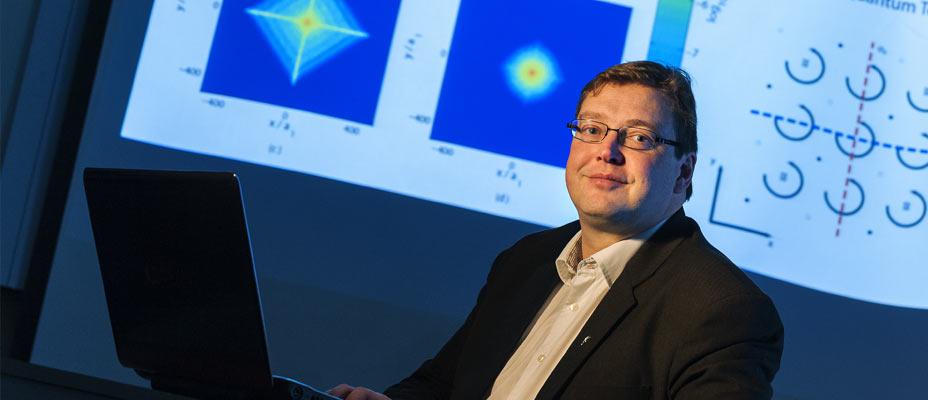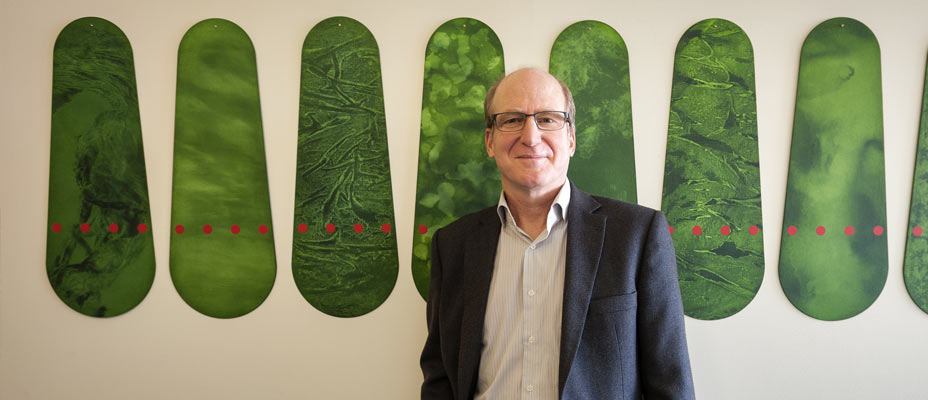
CoRE focus
The University of Otago will be a key player in new Centres of Research Excellence.
"It’s hugely positive for the University to have recognition through hosting or co-hosting two CoREs and having strong, powerful and tangible partnership in five of the six CoREs."
Reflecting on Otago’s selection as the host of one Centre of Research Excellence (CoRE) and the co-host of a second, Deputy Vice-Chancellor Research and Enterprise Professor Richard Blaikie says he is reminded of New Zealand Nobel Laureate Alan MacDiarmid.
"When he was asked how do you get a Nobel prize, he replied: ‘You have a good idea, you get the right people together and you work, work, work.’ It’s a similar thing with a CoRE."
Otago will host the Dodd-Walls Centre for Photonic and Quantum Technologies, with Associate Professor David Hutchinson, from the Department of Physics, as director, and will co-host Brain Research New Zealand – Rangahau Roro Aotearoa with the University of Auckland. Professor Cliff Abraham (Psychology) will be in a co-director role with Professor Richard Faull (Auckland).
Blaikie says it is recognition for the efforts of many.
"We’ve got outstanding academic and professional staff to support these CoREs. We highly value the contribution they make not only to the technical elements of the research, but also the professional processes needed to ensure that we properly manage the significant amounts of funding that flow."
– Professor Richard Blaikie
"These centres typically will be funded at the level of about $5 million per annum of taxpayers' money so stewardship requires efficient, but robust processes," he says.
"Governance and the oversight elements are important and if the Tertiary Education Commission and the selection panels didn't have confidence in our processes and structures they wouldn't fund these CoREs."
Blaikie says the Dodd-Walls Centre for Photonic and Quantum Technologies represents national recognition of leadership in that field.
"We will be leading a strong partnership in a high-tech area so that’s got huge opportunities, not only for pushing boundaries in knowledge in the powerful world of quantum technologies, but also to develop applied ideas to new commercial technologies.
"New Zealand is very good at creating niche companies that go out into a global market place."
Blaikie says the Brain Research New Zealand – Rangahau Roro Aotearoa will be an excellent example of the importance of partnership in CoREs.
"It will be truly co-hosted and co-led in a very transparent partnership between the University of Otago and the University of Auckland. It will nicely cement local, regional and national links, and gives more opportunity for a global presence in this area."
Otago continues to be a strong partner in CoREs based at other institutions. For example, the MacDiarmid Institute and its focus on advanced materials and nanotechnologies, and the Medical Device Research Institute, based in Auckland.
"Rather than one institution reinventing what others are already doing and trying to compete with them, there is much more to be gained from learning from them and bringing our knowledge and strengths into that."
Dodd-Walls Centre for Photonic and Quantum Technologies
Named after two of New Zealand’s pioneering researchers in quantum physics, Professors Jack Dodd and Dan Walls, the Dodd-Walls Centre for Photonic and Quantum Technologies aims to be a world-class collaborative research network, building on New Zealand's internationally acknowledged strength in the fields of quantum optics, photonics and precision atomic physics.
Associate Professor David Hutchinson (Physics, above), who has been named director of the new CoRE, says the Dodd-Walls Centre has already been running for about seven years as a collaboration between Otago and the University of Auckland, involving a group of leading researchers.
Achieving CoRE status means expansion to encompass researchers from five of New Zealand's universities.
"More importantly, we can now develop the work performed by excellent individuals, with project-based funding such as a Marsden, into a coherent whole which can have real national and international impact," he says.
"Photonics is the science of light at the most fundamental, quantum level. The centre’s research concentrates on the manipulation of light and the control of matter at the atomic scale through the use of light.
"Our aim is to undertake cutting-edge translational research – research that has potential real-world application in the nearer term – as well as generate fundamental knowledge about how the physical universe is composed and behaves."
At one end of the range there is an Otago research lab which uses laser light to trap and hold single atoms with the aim of bringing them together to see how they interact. The objective is to have complete control over the atoms so they can carry out what is effectively quantum chemistry, working with the very building blocks of matter.
At the other end of the scale there are researchers developing fibre-optic strain gauges which could be used to measure when buildings are under stress in earthquake-prone parts of the country.
Optical technologies research has applications in areas such as improved detection of bacteria in food products and also the development of advanced medical imaging, using light to probe deeper into the surface of skin to detect cancer.
"You get a different ‘signal’ from cancerous tissue to non-cancerous. Different types of tumour give back different signatures," says Hutchinson.
“It is also exciting to see potential new technologies coming out of the fundamental work being carried out in the centre.” This includes using Otago’s ultra-cold atoms expertise in the development of precision gravitometers and tiny gyroscopes, and using high performance optical filters that were developed for quantum computing being investigated for medical imaging.
Hutchinson says the centre will also educate and mentor highly-skilled individuals to continue the work in this field, and provide pathways for commercialisation of research and career development.
They already use their successful Lighthouse Platform to engage with companies across New Zealand that use photonics or light, either in fabrication or as part of their business.
Alongside that, Hutchinson expects the CoRE to help generate more new technology and start-up companies.
"We might take an idea developed to solve a problem in our research labs and get a company working in the field to develop it for commercialisation. We do the 'R' and they do the ‘D’."
It also allows them to develop career pathways for graduates by letting companies know who is entering the job market and the skills they offer.
"It’s about career pathways and keeping these high-tech people, who cost a lot of money to train, in New Zealand."
There are also plans to develop education outreach through having an educator in a Centre for Illumination at Otago Museum and take programmes to other museums such as Te Papa and the Auckland War Memorial Museum.
"To top it off, next year is the International Year of Light and so wonderful timing to launch this new CoRE and its associated education programmes."
Brain Research New Zealand - Rangahau Roro Aotearoa

Professor Cliff Abraham:"By bringing together the technologies and expertise from around the country, we will produce new streams of sophisticated and advanced research with a long-term translational focus to address this key health issue for New Zealand."
Brain Research New Zealand – Rangahau Roro Aotearoa has a clear vision: to enable New Zealanders to age well with a healthy brain.
It will bring together the internationally recognised research strengths of both the University of Otago and the University of Auckland, which will co-host the CoRE, under the leadership of co-directors Professor Cliff Abraham (Otago, above) and Professor Richard Faull (Auckland).
Abraham says they have been wanting to generate this collaborative effort for some time.
"Our aim is to understand the biology of the ageing brain, and develop new therapies and better clinical and community care to enhance lifelong brain health for all New Zealanders."
"We thought a jointly hosted centre would be the most effective – as well as providing a signal that this is a truly national effort."
Abraham says it was decided to focus on ageing-related neurological disorders because it is a major problem for most western societies.
"By 2036 one in four New Zealanders aged over 65 will be disabled by an ageing-related brain disorder.
"These disorders are accompanied by immense personal, social, economic and health-care costs that will increase quite dramatically with time. Direct health-care costs associated with these disorders are already estimated to be over $1 billion per year, not to mention the huge physical and emotional strains placed on individuals, family and whānau."
Brain Research New Zealand will draw the country’s world-class brain research capability into a cohesive national team involving the Centre for Brain Research at the University of Auckland, the Brain Health Research Centre at the University of Otago, AUT University and the New Zealand Brain Research Institute in Christchurch. The latter involves both the University of Canterbury and the University of Otago.
"Both Otago and Auckland have interests in stroke and Alzheimer’s disease, Huntington’s disease, Parkinson’s disease. Among other strengths, Otago has the nation's only academic neurosurgery unit, while Auckland hosts the Human Brain Bank which is a significant national and international resource that is available for collaborative research," says Abraham.
"The New Zealand Brain Research Institute has a strong expertise in Parkinson’s disease research and the group at AUT has strengths in epidemiology and public health, particularly around the area of stroke and traumatic brain injury."
As a result Brain Research New Zealand – Rangahau Roro Aotearoa forms a grouping of about 70 people working as principal investigators or associate investigators.
"Many are clinicians, which is a real advantage, because we're keen to pursue translational research; that is, research that ultimately will have real-world benefit in the clinic."
The CoRE will focus on four main themes: ageing and disease mechanisms, disease biomarkers, harnessing brain plasticity, and testing new therapies and lifestyle interventions, as well as public dissemination of new findings and information relating to brain health during ageing.
The disease mechanisms research will look to understand more about ageing-related neurological diseases and develop new therapeutic approaches, while the disease biomarkers research will look at ways of identifying people with neuro-degenerative conditions earlier in the disease course so interventions can start sooner.
Abraham says finding ways to harness the brain’s natural plasticity could help keep or restore function and combat disease, perhaps through drugs or brain stimulation techniques.
"The brain is built to be plastic and modifiable so it can learn and adapt to the environment; similar mechanisms can be brought into play to respond to disease or injury."
The interventions and outreach research will look at epidemiology, such as risk factors for stroke, as well as cognitive and lifestyle interventions. It will also examine areas such as health economics, and care and stimulation of the elderly in rest homes.
Abraham says the research will thus cover a whole range of analyses from cells and disease mechanisms, right through to human interventions and clinical trials.
"It’s not just more of the same research. By bringing together the technologies and expertise from around the country, we will produce new streams of sophisticated and advanced research with a long-term translational focus to address this key health issue for New Zealand."
MARK WRIGHT